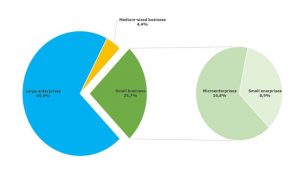 Small business accounts of 30% of the annual revenue of Russian businesses. This assessment is based on an analysis by Credinform Russia of financial statements of the fiscal year of 2016.
Small business accounts of 30% of the annual revenue of Russian businesses. This assessment is based on an analysis by Credinform Russia of financial statements of the fiscal year of 2016.
Since the beginning of market reforms in Russia, economists have argued about the important role of small business in the development of the domestic economy, as exemplified by other countries where the contribution of small and medium-sized companies in the GDP generation reaches 50% or more. This situation has existed for more than a century, particularly in Europe, while small and private business was excluded from the Russian economy during the period of 1917 to 1990. Subsequently small business had to re-establish itself albeit at a slow pace.
The Russian government continues to take measures to support entrepreneurial activity and facilitate private business initiatives. Exempted small businesses from tax body inspections, offered tax holidays for newly established companies; simplified financial reporting forms and is granting access to state procurement. Notwithstanding of these initiatives, problems persist in regard to high level of fiscal burden, excessive administrative regulations, as well as the lack of access to affordable financing. All of which retards the development of small businesses negatively affecting the Russian business infrastructure.
Credinform has recently published statistics of the makeup of the Russian business infrastructure based on the analysis of 2.3 million active Russian enterprises¹. Accordingly large enterprises still play a leading role in the Russian economy accounting for almost 70% of total revenue. The share of medium-size companies accounts for 4.4% of annual revenue, while he share of small business is 25.7%, 16.8% of which is generated by micro enterprises and 8.9% for small companies (see illustration).
Criteria for being qualified as micro, small or medium-sized business are the following:
- Annual turnover should not exceed
- 875.000 USD for micro enterprises,
- 500.000 USD for small enterprises,
- 250.000 USD for medium enterprises;
- Average number of employees should not exceed
- 15 people for micro enterprises,
- 100 people for small enterprises,
- 250 people for medium enterprises.
Companies which don’t meet the above mentioned criteria belong to a large business sector.
¹Information and Analytical system Globas https://globasnew.credinform.ru/en-GB/home.
The development of small forms of entrepreneurship meets the needs of all spheres of the Russian economy and trends of world economic processes. Being a purely market structure, small business is able to provide freedom of choice and stimulate the effective organization of  production. Small business is one of the most flexible economy sectors, in which innovative approach and relatively high growth rates are combined with relatively low foundation expenses.
production. Small business is one of the most flexible economy sectors, in which innovative approach and relatively high growth rates are combined with relatively low foundation expenses.
Source: Credinform Russia http://www.credinform.ru/en-US























